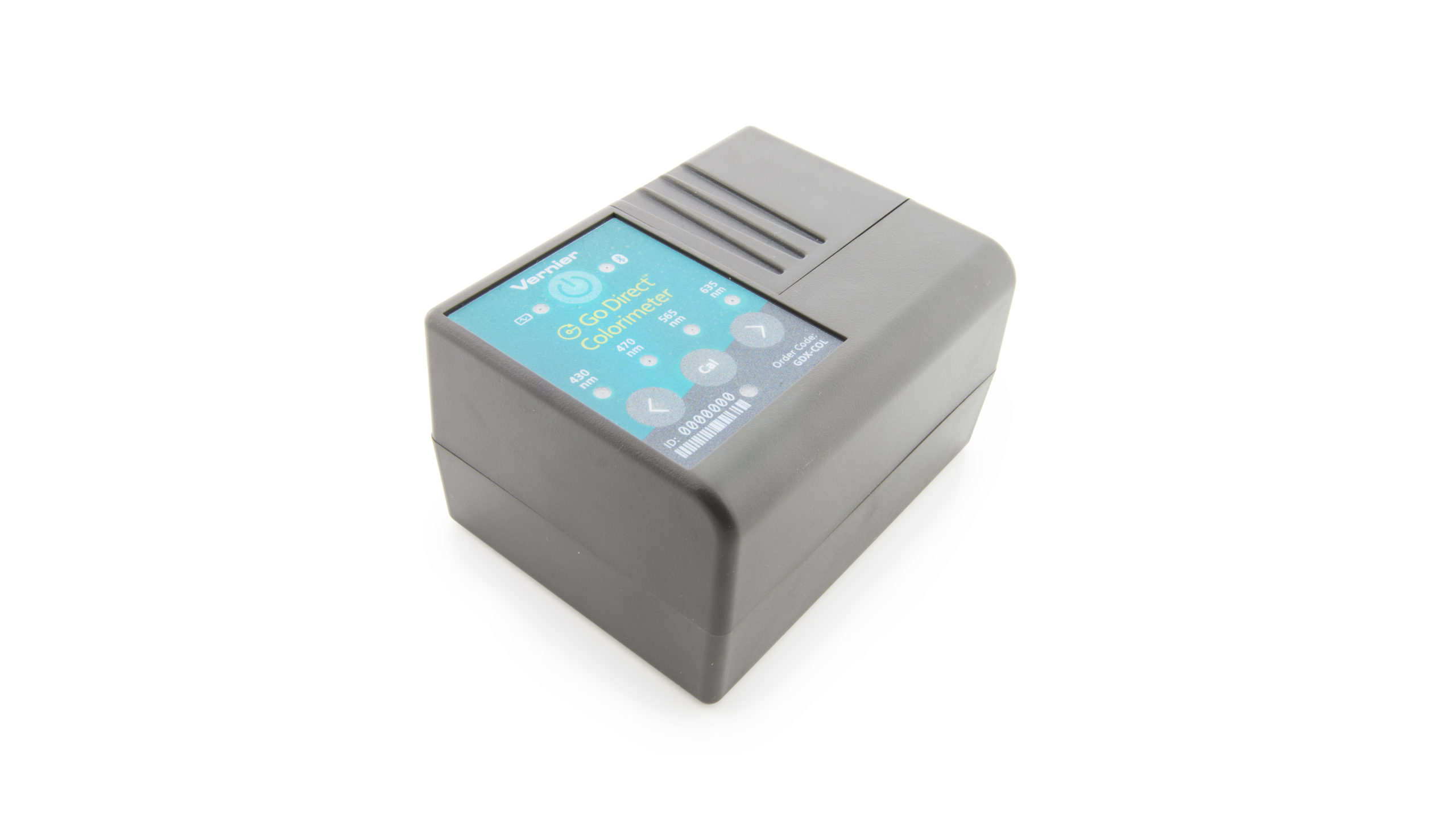Troubleshooting
General: Press the power button on the sensor to turn it on. Connect your sensor as described in the Getting Started instructions for your device. (The green LED will flash to indicate the sensor is connected.)
- Primary Test: Allow the Colorimeter to warm up for 5 minutes. Place a cuvette, about 3/4 full of distilled water, in the Colorimeter and close the lid. Select a wavelength. Press and hold the CAL button on the Colorimeter. When the red LED begins to flash, release the CAL button. When the red LED stops flashing, the Colorimeter is calibrated. Check the absorbance readings, which should be very nearly zero.
- Secondary test: Prepare a solution with a color (a simple test solution for the 635 nm wavelength setting can be made by adding 2 drops of green food coloring to 100 mL of tap water). After calibrating the Colorimeter, fill a cuvette about 3/4 full with the test solution. Place the cuvette in the Colorimeter and close the lid. The absorbance readings should change to a reading between 0.8 – 1.5. You may dilute the test solution and place a cuvette of the dilute solution in the Colorimeter to check the change in absorbance.
The normal, most useful absorbance range is 0.05 – 1.0, or 10% – 90% transmittance.
Usage Tips
- When you press the CAL button, make sure the red LED lights flash several times. You may still have to wait a few seconds after the red LED stops flashing before the absorbance reading is ~0.000 or the % transmittance is ~100.0%.
- If you calibrated with a cuvette of water and then remove this cuvette of water, it is expected that the absorbance value will no longer be 0.000 or the % transmittance may be much lower than 100.0% (even as low as 70%). If you put the cuvette of water back in the Colorimeter, the absorbance will return to ~0.000 or the % transmittance will return to ~100.0%.
- If you switch to a new wavelength, you need to calibrate the Colorimeter again.
- If your solution is very dark and you are getting absorbance readings greater than 2.00, then dilute your solution. Solutions should typically be fairly translucent to get accurate readings with the Colorimeter.
Additional Troubleshooting
GENERAL
- How does a colorimeter compare to a spectrometer?
- Do you sell replacement lids for your plastic cuvettes?
- Why don't the absorbance readings for the colorimeters and spectrometers have units?
OPERATION
- My Colorimeter is not working properly. What should I do?
- Why don't all of my spectrometers and/or colorimeters read the same absorbance value for the same sample?
- My Go Direct Colorimeter battery indicator light stays orange despite hours of charging.
EXPERIMENTS
- How do I run the AP Chemistry food dye lab with a colorimeter instead of a spectrophotometer?
- Is it possible to measure turbidity with the colorimeter?
MAINTENANCE & STORAGE
Specifications
- Range:
⚬ 0 to 3 (absorbance)
⚬ 100 to 0 %T (transmittance) - Useful range:
⚬ 0.05 to 1.0 (absorbance)
⚬ 90 to 10 %T (transmittance) - Wavelengths: 430 nm, 470 nm, 565 nm, 635 nm
- Connections:
⚬ Wireless: Bluetooth® v4.2 (wireless range 30 m unobstructed)
⚬ Wired: USB 2.0 full speed - Battery: 300 mA Li-Poly
⚬ Battery Life (single, full charge): ~8 hours continuous data collection
⚬ Battery Life (lifetime): 2 – 5 years (typical)
Calibration
Calibration? Yes, each time before use.
- Connect the Colorimeter to your platform and start the data collection software.
- Allow the Colorimeter to warm up for 5 minutes.
- Select a wavelength.
- Open the lid, insert a cuvette filled about 3/4 full of distilled water, and close the lid. Make sure that one clear side of the cuvette is lined up with the arrow at the top of the cuvette slot.
- Press the CAL button and hold it until the red LED begins to flash and then release the CAL button. When the LED stops flashing, the calibration is complete.
Battery Troubleshooting
- If the sensor can be turned on when connected by USB but not when disconnected from USB, the battery either needs charging.
⚬ Try charging the sensor for several hours and testing again. - If after charging the battery the sensor turns on while connected via USB and briefly connects to Graphical Analysis but gives repeated communication errors and/or resets the selected wavelength, then the battery may be bad. To verify this is a battery issue (and not a bad USB port or cable), try swapping the battery with a working sensor to see if the problem follows the battery or stays with the sensor.
⚬ If the problem stays with the sensor, the battery is probably not the issue.
⚬ If the problem follows the battery, the battery has likely reached its end of life. - In this state, the sensor cannot be used even if connected by USB, so the battery will need to be replaced. Go Direct® 300 mAh Replacement Battery (
GDX-BAT-300 ) - See How do I remove or replace a Go Direct battery? for more information (including a video).
Rechargeable batteries are covered by a one-year warranty.
Batteries should last two to five years in typical use.
Related Products
- Micro USB to USB-C Cable (
CB-USB-C-MICRO ) - Go Direct® Charge Station (
GDX-CRG ) - Cuvette Rack (
CUV-RACK ) - Colorimeter (
COL-BTA )
Replacement Parts
- Go Direct® 300 mAh Replacement Battery (
GDX-BAT-300 ) - Micro USB Cable (
CB-USB-MICRO ) - Plastic Cuvettes (Visible Range) (
CUV )

